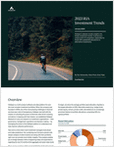| Index | February 2004 | QTD | YTD | Description |
| S&P 500 Index* | 1.22% | 2.97% | 2.97% | Large-cap stocks |
| DJIA* | 0.91% | 1.24% | 1.24% | Large-cap stocks |
| Nasdaq Comp.* | -1.76% | 1.32% | 1.32% | Large-cap tech stocks |
| Russell 1000 Growth | 0.64% | 2.69% | 2.69% | Large-cap growth stocks |
| Russell 1000 Value | 2.14% | 3.94% | 3.94% | Large-cap value stocks |
| Russell 2000 Growth | -0.15% | 5.09% | 5.09% | Small-cap growth stocks |
| Russell 2000 Value | 1.94% | 5.46% | 5.46% | Small-cap value stocks |
| MSCI EAFE | 2.33% | 3.78% | 3.78% | Europe, Australasia & Far East Index |
| Lehman Aggregate | 1.08% | 1.90% | 1.90% | U.S. Government Bonds |
| Lehman High Yield | -0.25% | 1.65% | 1.65% | High-yield corporate bonds |
| Carr CTA Index | 3.42% | 4.42% | 4.42% | Managed futures |
| 3-month Treasury Bill | . | . | 0.15% | |
| Estimates as of February 29, 2004. *Return numbers do not include dividends. |
In the esoteric world of alternative investments, arbitrage managers are charged with the responsibility of hedging out the risk of a select basket of financial instruments. The risks are typically hedged in such a way that only a teeny sliver of the original risk remains. As a result, the only way for arbitrageurs to make a decent return is to leverage up their positions. The current environment of low interest rates and low market volatility is quite conducive to this type of gearing.
This period of relatively easy credit has spawned a new beast, the leveraged hedged fund of funds (FoF). A fund of funds may use a number of borrowing facilities to invest in a portfolio of other funds, with the net result being an interdependent web of investments, all purchased with borrowings. This structure is not without risk; a relatively small loss at the hedge fund level could potentially result in a catastrophic loss higher up the chain. There are far greater systemic implications if the web were to unravel due to losses in a particular strategy, such as convertible arbitrage.
With the combination of steady returns and low interest rates, it is not hard to fathom why fund-of-funds managers might find other uses for leverage. In the absence of difficult periods, the temptation to enhance returns using outright gearing increases. This is especially true if competitive forces require managers to produce higher returns, and if unleveraged funds are lagging.
The most judicious use of borrowing is to increase the diversification of the portfolio, and thus reduce its volatility. The intention–to produce a more steady return through large-scale diversification than would have been possible without the use of borrowed funds–is honorable. But in most cases, funds of funds are leveraged simply to increase absolute returns.








 March 24, 2004 at 07:00 PM
March 24, 2004 at 07:00 PM










